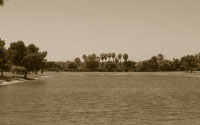Mission Bay History

Mission Bay Park was developed from the 1940s through the 1960s using a tidal marsh named "False Bay" by Juan Rodriguez Cabrillo in 1542. The San Diego River had historically shifted its terminus from San Diego Bay to the south, to "False Bay" to the north, until 1852 when the United States Army constructed the first dike along the south side of the river to prevent it from shifting back to San Diego Bay. This made "False Bay" an estuaries outlet for San Diego River drainage. The dike failed shortly after its construction was finished, but paved the way for the current San Diego River flood control channel. During the late 1800s some recreational development began in "False Bay," including the building of hunting and fishing facilities. These facilities were destroyed by flooding that took place years later.
In 1944, a Chamber of Commerce committee recommended development of Mission Bay into a tourist and recreational center to help diversify the City's economy, which was largely military. In the late 1940s, dredging and filling operations began converting the marsh into the jewel that is today Mission Bay Park. Twenty-five millions cubic yards of sand and silt were dredged to create the land forms of the park, which now is almost entirely man-made. Today, the San Diego River is constrained on both the north and the south by levees (San Diego River Flood Control Channel), and it no longer drains to the ocean through Mission Bay other than a weir located at the entrance to Mission Bay.
Approximately one half of the park was once state tidelands. Mission Bay Park was transferred to the City of San Diego with several restrictions, some of which were adopted by the Citizen of San Diego for adoption into San Diego City Charter with others implemented as part of the California Coastal Commission's oversight of local planning and land use decisions. Among the limitations are:
- a ban on permanent residential development or any private ownership of land within the tidelands, and
- a limit on commercial development of leaseholds of no more than 25% of the land area and 6.5% of the water area for private purposes.
This assures that most of the acres making up Mission Bay Park are available for public recreational use.

